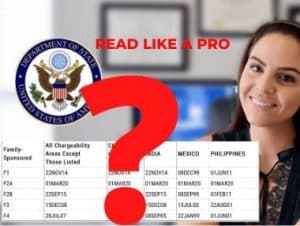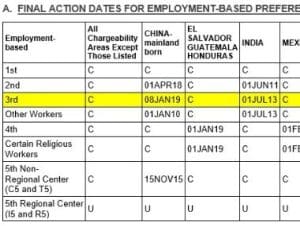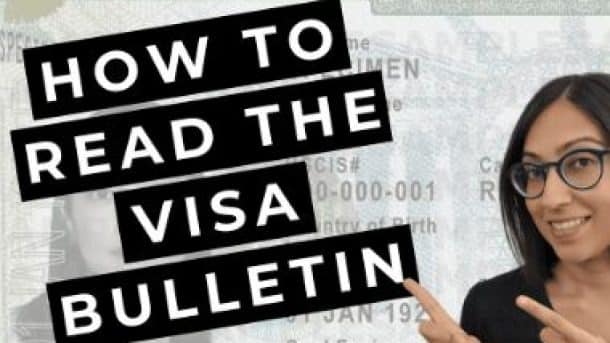You’ve undoubtedly heard of the Visa Bulletin if you or a family member currently holds a green card and you want to apply for one.
The Visa Bulletin: What Is It?
The Department of State publishes the visa bulletin each month. Based on the date of the initial filing of the I-130 petition, which initiates the green card process, it displays which applicants for green cards are eligible to proceed. Additionally, it allows you to project how long it will take you to receive your green card based on how quickly the current “line” is moving. You will be able to track your progress in line by checking the visa bulletin once your I-130 petition has been filed.
Here are the data from the most recent Visa Bulletin published by Boundless. Furthermore, Boundless provides excellent green card assistance at a low cost. Find out more right now.
The following provides all the information you require regarding this significant monthly update, however for family members applying for green cards, this is the main takeaway:
- You don’t even need to read the visa bulletin if you’re a U.S. citizen’s spouse, parent, or unmarried child (under age 21)—you won’t be waiting in line for a green card!
- You will need to wait an additional 12 to 18 months for your green card to become available if you are the spouse or unmarried child (under 21) of a U.S. green card holder.
- Your wait period for a green card could be years or even decades if you fall into a different group.
Backlogs for Green Cards and the Visa Bulletin
Congress has placed a cap on the annual number of green cards that can be issued, which is why there is a visa bulletin. This annual cap has been regularly exceeded by the number of people applying for green cards, resulting in a backlog—in fact, multiple backlogs.
Currently, 366,000 green cards are granted annually; however, this number is divided into numerous categories, each of which has a set quota. The two widest categories are employment-based green cards (140 000) and family-based green cards (226,000), which include marriage-based green cards.
Congress has limited the total number of green cards that can be granted annually as well as the quantity of cards that can be obtained based on a person’s country of origin.
A single nation of origin cannot account for more than 7% of the green cards in any given category under this yearly “country cap.”
For a nation with an 11 million inhabitants, like Belgium, that wouldn’t be a huge concern; in fact, no country in Europe or Africa produces enough demand for green cards to exceed the national cap. However, there are huge backlogs that the numerous individuals applying for green cards from China (1.4 billion people), India (1.3 billion people), Mexico (129 million people), and the Philippines (105 million people) must contend with.
How the Visa Bulletin Should Be Read

There are four main “preference categories” that comprise the caps on family-based green card applications.
F1 (priority 1):
Adults who are single and over 21 who are American citizens’ children. There is an annual cap of 23,400 green cards for this category.
F2 (second preference):
Green card holders’ spouses and single children. This category has a 114,200 green card annual cap, although it is divided into two subcategories:
- F2A: Green card holders’ spouses and unmarried minor children (under age 21). When you check the visa bulletin, you should keep an eye out for this category if you are a green card holder who has applied for your spouse’s green card.This F2A subcategory receives 77% of the second category quota, or 87,934 green cards annually.
- F2B: Adult children of green card holders who are single and over the age of 21. This F2B subcategory receives 23% of the second category quota, or 26,266 green cards annually.
F3 (third preference):
Married children of citizens of the United States, irrespective of age. There is an annual cap of 23,400 green cards for this category.
F4 (fourth preference):
American citizens’ brothers and sisters. There is an annual cap of 65,000 green cards for this category.
Why Is the F2A Category Unique?
The wait for a green card under the F2A category is far shorter than it is under any other family-based preference category, as you can see if you check the visa bulletin. If you’re the spouse of someone with a green card in the US, this is great news!
This group advances the fastest for two reasons. First of all, with 87,934 green cards, it has the highest quota. Furthermore, of the green cards that fall within the F2A category, 75% are excluded from the aforementioned nation cap. Therefore, a spouse applying for a green card has significantly less significance based on their nation of origin than does an application under a different category.
What About US Citizens’ Wives?
The number of green cards that can be obtained by spouses, parents, and unmarried minor children (under age 21) of U.S. citizens is unlimited. There is no backlog, no waiting line, and nothing to see in the visa bulletin because there is no yearly restriction. As soon as their I-130 petition is accepted, spouses of citizens of the United States may apply for a green card.
Crucial Terms in the Bulletin on Visas
- Date of priority: On this day, your I-130 petition was received by U.S. Citizenship and Immigration Services (USCIS). Consider this date as your entry point for the green card lottery. The I-797 paperwork that the USCIS mails you after granting your I-130 petition contains your priority date.
- Current: “Current” refers to the absence of a backlog and a waiting period for a green card in the context of the visa bulletin. When a specific priority date moves up in line and a green card becomes available, it becomes “current.” Alternatively, if there is no wait time or backlog inside a preference category, the category as a whole may be considered “current”.
- Chargeability area: This refers to the nationality of the green card application. (Recall the national cap? Your individual green card will be “charged” against the yearly cap of green cards granted to nationals of your native country.)
- An immediate relative is a U.S. citizen’s spouse, parent, or kid (under 21).
- Cut-off date: “Cut-off dates” are the dates that appear in the visa bulletin tables. Consider this day as the start of the immigration process. Green card petitioners may submit their applications as long as their priority dates are before the deadline. Those applying for green cards whose priority dates fall after the deadline must wait.
Section A: Last Dates for Action

Which priority dates have advanced to the front of the list are displayed in the “final action dates” chart. These green card applications are now pending approval.
Section B: Submission Deadlines
Even if a green card is not yet available, the “dates for filing” chart indicates which foreign nationals applying for a green card should submit their application to the National Visa Center (NVC) as soon as possible. Green card applicants are able to file their applications significantly earlier because the deadlines in the “dates for filing” chart are a little later (1–10 months) than those in the “final action dates” chart.
The “dates for filing” chart is mainly intended for those who will be applying for a green card from outside the country. However, USCIS releases a page titled “when to file your adjustment of status application” each month that clarifies whether or not applicants for green cards who are already in the country may submit their applications using the “dates for filing” chart from the visa bulletin, or if they must wait to meet the dates in the “final action dates” chart.
Why Does It Matter Which Dates These Are?

The “dates for filing” table gives non-US citizens applying for green cards the opportunity to start gathering and sending in the necessary paperwork to the National Visa Center (NVC) ahead of time.This starts the process and guarantees that everything is prepared by the NVC for when your priority date shows up on the “final action dates” table and you are granted a green card.
The “dates for filing” table provides access to extra benefits for those who apply for green cards and reside in the United States. That’s because you can apply for both a work permit (an employment authorization document) and a travel permit (an advance parole document) at the same time when submitting a green card application to USCIS (formally an I-485 form for “adjustment of status”). These extra perks might be quite helpful for applicants who want to work in the country or travel abroad while their green card applications are being processed.
Columns by Country
The visa bulletin features distinct columns for China, India, Mexico, and the Philippines, as you will observe. Because of their yearly demand for green cards exceeding the 7% “country cap” mentioned above, inhabitants of these four nations frequently have longer—and sometimes significantly longer—wait times for green cards. This implies that, in practice, each of these four countries has different backlogs and green card queues, which also differ according to the green card category.
But never forget that the F2A category is unique. Because the majority of green card applications in this category are excluded from the country cap, you’ll note that the wait time for a green card for spouses of U.S. green card holders is typically approximately the same regardless of the country of origin.In contrast to other relatives from China, India, Mexico, and the Philippines who may have to wait years or even more than a decade for their green cards, spouses from these nations just need to wait a few more weeks, if at all.
Retrogression: What Is It?
The deadlines for the visa bulletin typically advance over time, moving people seeking green cards up the queue.albeit not always. The deadlines for the following month may slip backwards if the number of applications for a particular green card category in a given month exceeds what USCIS or the State Department had anticipated. This phenomenon, known as “visa retrogression,” is most prevalent in September, when the government’s fiscal year comes to a conclusion.
Green card applicants may occasionally receive advance notice of impending retrogressions through the visa bulletin, allowing them to make necessary preparations. Occasionally, however, the visa bulletin notifies of an entirely unanticipated retrogression in visa requirements, which comes as a painful shock to applicants who were hoping to advance in line rather than regress.For this reason, it’s a good idea to get ready in advance with all the documentation required for your green card application so that you can submit it as soon as the visa bulletin indicates that you are eligible for one.If you don’t submit your application within the month that a green card becomes available, you run the danger of being unexpectedly retrogressed against in the upcoming visa bulletin, which would end your window of chance to apply for a green card.
USCIS or the State Department will hold your application until you return to the front of the line if you have already filed your green card application and there is a visa retrogression.Other than making sure that your contact information is current, there is nothing you need to do.
The outcome is the same if you haven’t submitted your green card application yet and there is a visa retrogression: you will have to wait to apply again until you are back at the top of the line. (Alternatively, in the words of the visa bulletin, until your priority date becomes current once more.)
Are you curious about the status of wait times and backlogs for green cards? Boundless publishes monthly visa bulletin explainers that deconstruct this procedure and highlight historical tendencies.
FAQs
What are final action dates in the visa bulletin?
The deadlines listed in the visa bulletin’s final action dates dictate whether or not an applicant for an immigrant visa or adjustment of status may move forward with their application. An applicant may proceed with their application if their priority date is earlier than the last action date for their category. They have to wait until their priority date becomes current before moving forward if it is later. The last action dates are subject to change every month and are dependent on the availability of visas.
What is a priority date in the context of the visa bulletin?
The day that the petition for an immigrant visa or adjustment of status is submitted to the USCIS is known as the priority date. It acts as a person’s queue for the availability of a visa. Because it determines when an applicant may move on with their application based on the final action dates specified in the Visa Bulletin, the priority date is very important. An individual often has a greater probability of moving forward in the immigration process if they have an earlier priority date.
How is the visa bulletin organised?
The two primary sections of the Visa Bulletin are dedicated to preferences based on work and family sponsorship. There are various categories and chargeability areas (countries) in each division. The Visa Bulletin contains charts that illustrate when to take final action, which determines the availability of visas, as well as filing date charts, which show when people can begin the application process but are not required to complete it. Other pertinent information, such as the use of visa numbers and any modifications or updates to the availability of visas, is also supplied by the Visa Bulletin.





